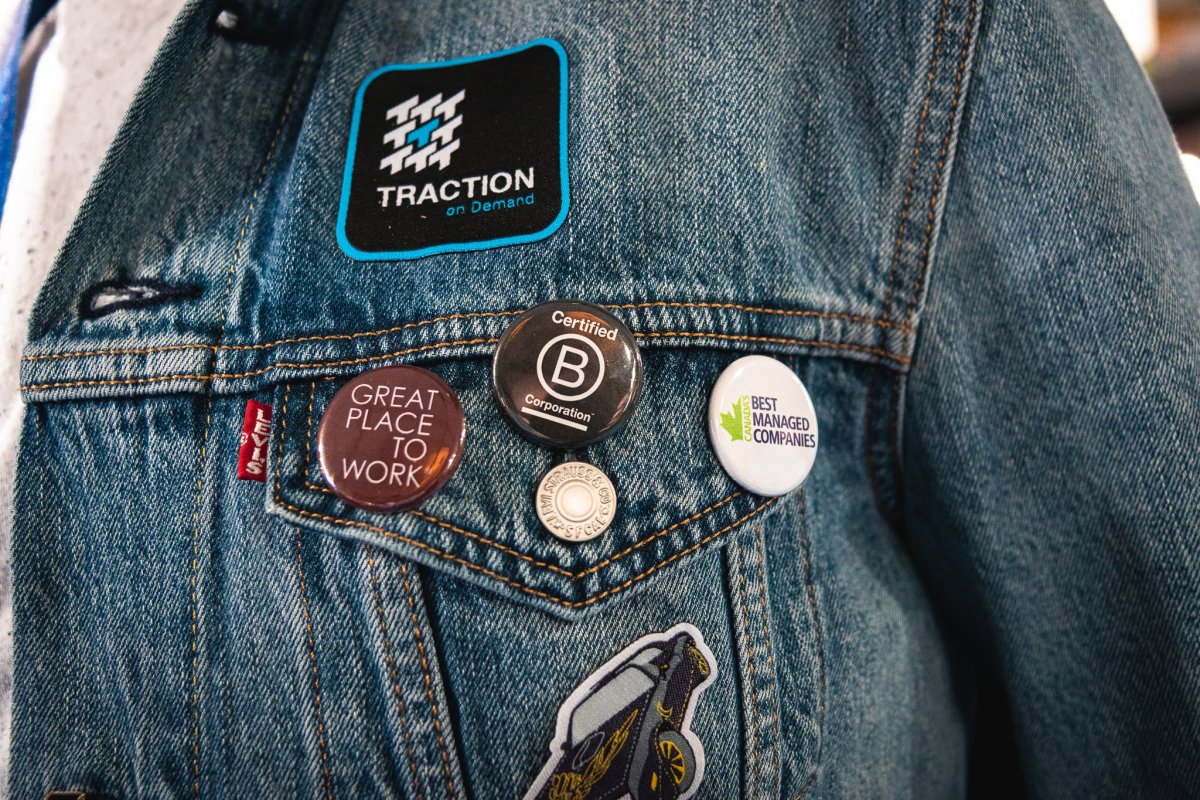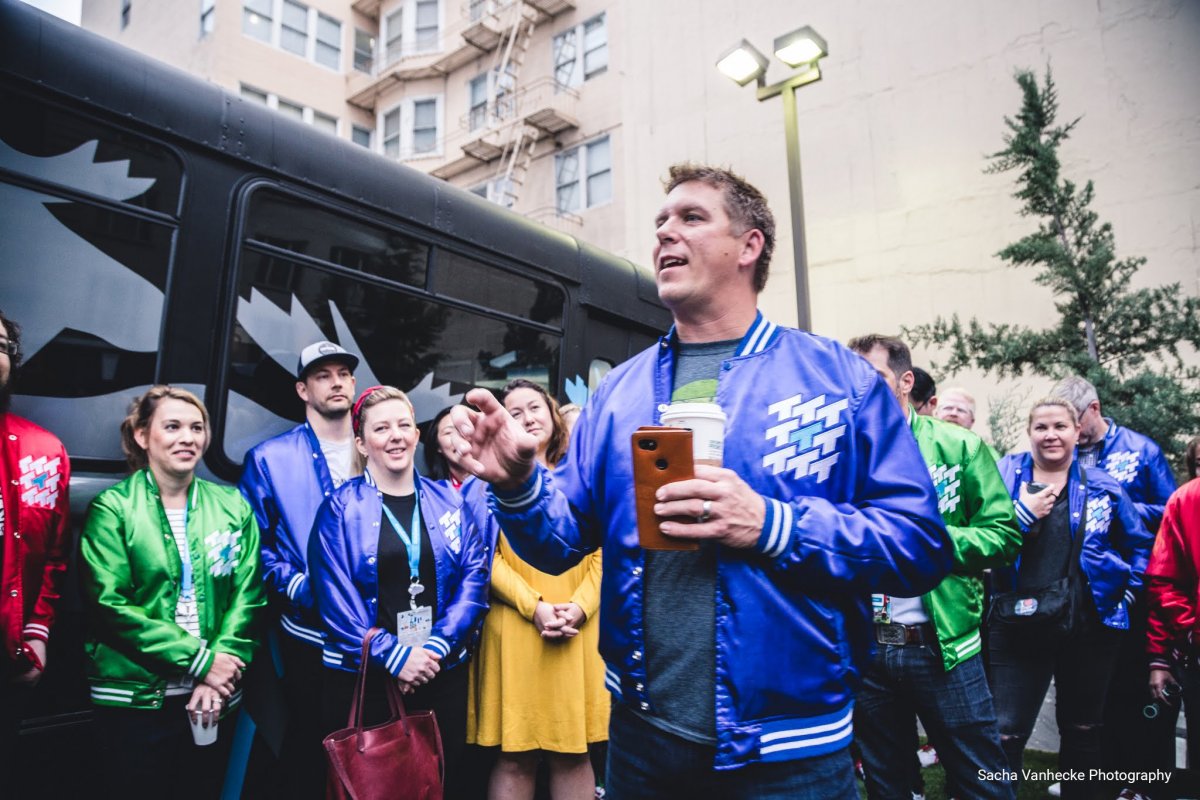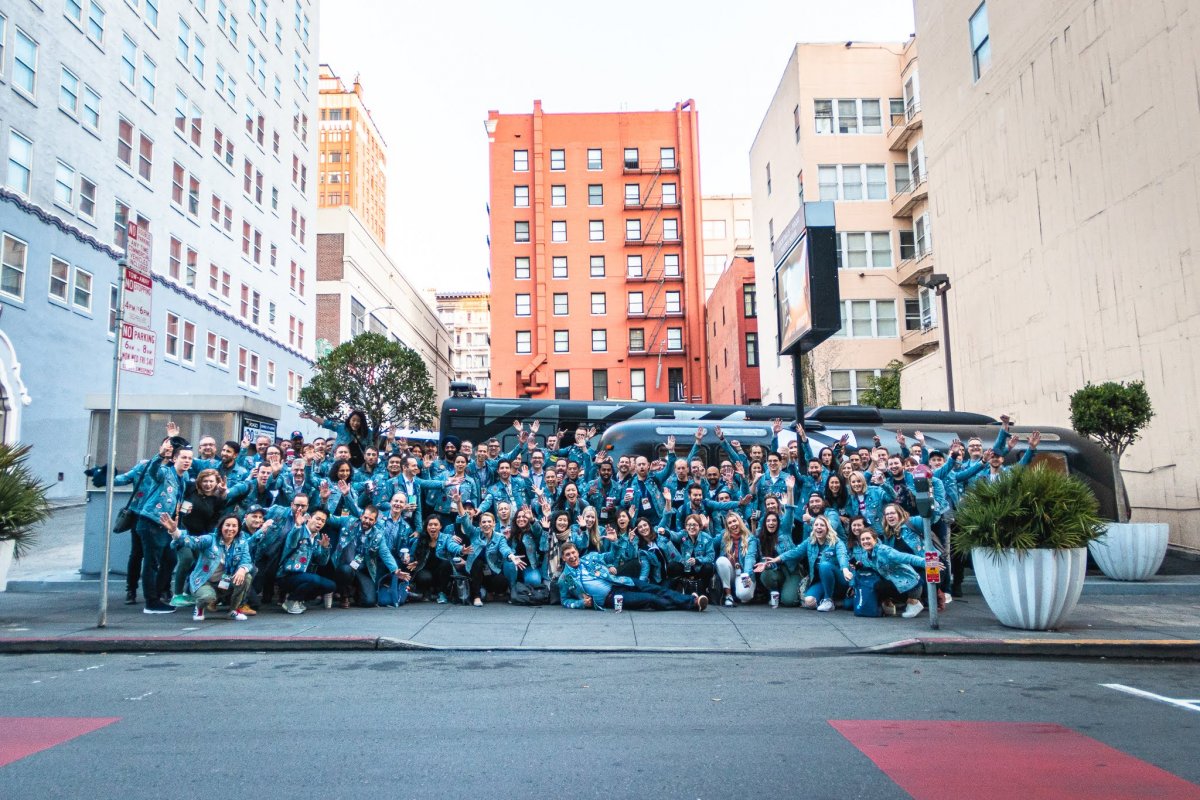[vc_row][vc_column][vc_column_text]
From negotiating his way into business school to leading over one thousand people. Here’s what Traction on Demand founder Greg Malpass has learned.
[/vc_column_text][vc_column_text]All great stories need some sort of conflict. For Greg Malpass, Founder of Traction on Demand, his entrepreneurial story began with having to negotiate his way into business school.
As a Kinesiology student with less than impressive grades, he had to convince business professors that he was worth taking a shot on—he was right.
Malpass took all that he learned—through school and the numerous jobs that followed—and built a Canadian success story. Sitting at over one thousand employees, Traction on Demand is one of North America’s largest Salesforce consulting and implementation firms.
Though the sheer size of Traction on Demand is an incredible feat in and of itself, Malpass’s ability to grow a company of its size strongly rooted in values is perhaps the most impressive. As the company’s leader, Malpass learned the importance of staying true to oneself early on and encouraged similar principles throughout the company.
“We make no decisions without consideration of our values, and we’ve had to make tough decisions too because some things were at risk of sacrificing our values,” says Malpass. “We believe we have an accountability to the community, we have an accountability to the planet, and we have an accountability to the mental wellbeing of the people that we serve directly and indirectly.”


As a Certified B Corporation, Traction on Demand puts people and the environment ahead of profit. Through its Traction for Good program, the company has taught over 800+ kids in coding and philanthropy workshops and provided over $2.5 million in grants to help nonprofits increase capacity.
In addition to his efforts to support the greater good, Malpass has shown the ingenuity of his business sense through the continued rapid growth of Traction on Demand. Building on the company’s service-based platform, Malpass launched software-based companies by listening to the needs of the market including bettr.me, Traction Rec, and Traction Guest.
“The resilience of an entrepreneur is a pretty magical thing, but entrepreneurs are at their best when there’s a big well-defined problem in front of them,” says Malpass. “That’s when we dig. We don’t always dig up; sometimes we need to dig sideways; sometimes we need to dig down and find a new avenue. The more you can be open to that and the quicker you can run through that cycle, the better.”
For this week’s Entrepreneur of the Week, Bay Street Bull spoke with Greg Malpass, Founder of Traction on Demand, about the lessons he’s learned from building a company of one to a company of one thousand and how values play a pivotal role in ensuring a company’s success.[/vc_column_text][vc_text_separator title=”Q&A” color=”custom” style=”double” border_width=”3″ accent_color=”#0a97fc”][vc_row_inner][vc_column_inner][vc_column_text]You were originally studying kinesiology but had an interesting switch into business—care to elaborate how it all went down?
When we’re young, we always kind of look towards our parents as role models; I had so much respect for my father and his role as a physician. I was always in sports and I always wanted to help people. So what better job could there be than a kinesiologist or a sports medicine doctor? I’d get to be kind of like my dad but also forge my own path.
One day I was hitchhiking actually to school and the gentleman that picked me up started asking me questions about what I’d like to do. I told them I wanted to be a sports medicine doctor and he said, “Oh, that’s interesting. Would you like to run a clinic or would you like to work in a clinic because they’re pretty different things?” And my response was, “I want to run a clinic.” He goes, “Well, are you doing sciences? You should learn how to run a business.”
So, with my terrible grades, I declared to the business faculty of my university that I wanted to join their faculty—then they saw my transcript.
I had to negotiate my way into every class, which was almost the most powerful part of my business education. The Dean would sign a document that would allow me to get in the class but only if the professor would allow me in. So for every single business class I took, I had to negotiate with the professor to get in. The objections were always, “Why should I take you when I already have a backlog of 500 students with better grades? Why should I choose you over them?” And so a lot of it was finding a way to articulate what I was going to do with the skills that they would teach me.
It was like selling yourself as a candidate to the business faculty—your first sales job if you will.
It was honestly negotiations and sales for sure. I think selling is in everything we do, whether you’re selling an idea, you’re selling yourself, you’re selling a product service, or you’re even figuring out how to sell yourself on an idea.
After university, you started in media, and even moved to Toronto at some point, but ended up moving back to the west coast. What compelled you to move back home and go on your own route?
The move to Toronto was because I met an incredible entrepreneur named Justin Poy. Part of my negotiations [for business school], was that I had to be the president of multiple clubs. And I met Justin as one of the judges for a school competition. He was a very successful leader running an advertising and digital design agency, and he offered me a job. I thought, “If I want to learn how to run a business, to be able to work directly with someone who’s built a business would be pretty powerful.” So, I worked for Justin for a couple of years in Toronto and recognized a couple of things.
One is that roots grow fast. A really important part of your career is making sure that you’re building a network that you’re going to continually have interaction with. I also started realizing that my heart was out West. I loved the mountains. I grew up in a small town of 8000 people, close to ski hills and lakes, and Toronto was an incredible opportunity career-wise, but it wasn’t the remote lakes and wilderness that I had grown to love. This was right around Y2K, when things weren’t so great in the technology industry. I saw this moment of pause and thought, “This is probably my only chance to make a move and do a reset.” So, I threw everything in a U-Haul and headed west without a job.


Wow! You did end up finding your roots back home and were able to build up your own business. What was it like going from learning and working with someone to being your own boss and juggling all of the tasks of an entrepreneur?
There were a couple of jobs in between [leaving Toronto and entrepreneurship]. I worked for a larger agency out here in Vancouver, Cossette Communications. And in that job, I really framed my job to be around annual reports because I loved working with executives. So, I had the opportunity to work with public CEOs, figuring out their messaging. Then, one of my customers, Crystal Decisions, hired me. I worked there for a couple of years—great company—and I just realized a pattern was starting to form: every two years, I quit.
Why did I quit? I actually had performance anxiety. I thought I was going to beat my employers to it. I always operated as if I was going to be fired. So I decided, after three rounds of that, maybe companies just aren’t for me. I love serving people. I’m quick to adapt to situations. Why wouldn’t I just try to go out on my own? So, I called a couple of my previous customers and said, “Hey, I’m thinking about going on my own. We’ve done this before together. Would you consider signing me on for a contract?” And in both cases, the customer said yes.
In the first four years, holy smokes, things got busy. I was running upwards of 25, 30 customers at one time—just me! So I had to get efficient. I was very responsive in terms of what people wanted and listened to what it was they were actually buying from me. More and more, they started asking for Salesforce. It wasn’t me saying “I’m going to be a Salesforce consultant.” More and more of my customers were saying, “Hey, we need help with Salesforce.”
What’s it been like to see the company grow from one person running 25, 30 accounts to a team of over one thousand people?
There are probably 15 different versions of myself throughout that journey. Those customers that I was serving were people I revered as friends and to hand over the responsibility of caring for those customers, to people who weren’t myself, was tough. Learning to delegate and to trust people was a whole stage. Once we got up to 10 people, all of a sudden, I had to learn how to lead people. I couldn’t just work within a team and be part of the team, I had to learn what a good leader was.
A big part of that was finding mentors and going back to old leaders that I worked for (and who were good leaders in my perspective) and asking them how they did it. Then as Traction On Demand grew up to a hundred people, there was just this invisible ceiling within the company itself. For any entrepreneur, anyone who’s looking at growth, you will fail around a hundred people a couple of times until you rethink things. The reason is that you need to introduce the beginning of the middle layer of management, which is very tough culturally on an organization because everybody has direct connections.
Now, a big part of my world is that I don’t actually get to do anything. I initiate systems and try to put in place good systems and good frameworks that I can trust people will apply creativity and ingenuity to. And so, it’s been really interesting. The one thing that’s been important, and I think a huge ingredient to our success thus far, is I didn’t hire anyone like me. I have a quick, get it done attitude and I held high regard for people who had a different approach to things. So, I found people I admired, people that were very procedurally focused and much more craft-focused. What’s interesting about that is it allowed the business to transcend me.
I think it is important to not seek yourself out in an employee—as great as we all think we are. You have to see things from the other side.
Also, one of the things that we say very frequently at Traction on Demand is just because it made sense, doesn’t mean it makes sense. We talk about the company being very rooted in its values, but the truth is, the values of a company should be the sum of the people’s values. Companies are communities. And so, we’ve had to lay a lot of ideas to rest and say, “That made sense then but doesn’t make sense now.” And in some cases, we also look backward and say, “Hey, remember that thing that didn’t make any sense? Maybe we have the capability to be successful now.”
As humans, we want to slot, sort and move forward. It’s just the way we are. Everyone organizes their kitchen cabinets in a certain way because it gives us a sense of progress. But the truth is, every once in a while you have to take everything out of the shelves, look at it again and make sure everything is going in the right place. And also look at what you’re trying to do and see which tools you need. It’s not a hoarder’s world, that’s for sure.


I started the business at a time when my life was very simple. Of course, we add layers of complexity: partners, children, etc. So I had to learn what work-life harmony was. One thing that came to light was that if I couldn’t be my true authentic self, it’s just business. And that’s a very terrible thing to think about because that means you can behave differently in one context than the other, but you’re one person. The more consistent we can be, the more we can make ourselves better. So, we are very values-rooted.
We make no decisions without consideration of our values, and we’ve had to make tough decisions too because some things were at risk of sacrificing our values. We believe we have an accountability to the community, we have an accountability to the planet, and we have an accountability to the mental wellbeing of the people that we serve directly and indirectly. And we’ve learned there’s a lot of people that think that way in the world. In fact, people that think that way are typically more successful than people that don’t.
The world and universe have taught us you can do good and make money, but you can’t do good to make money. Things get hard, fast, and that’s when true colors show. People want to associate with organizations and people that they know they can trust and that they know are consistent. Living through this pandemic and through the circumstances that we’re in today, people are voting with their jobs and they’re voting with their dollars. It’s amazing. I think the world’s changing and work’s changing as a result of it. And it’s better.
Over the last 15 or so years with Traction On Demand was there ever a major learning curve or big lesson that changed your trajectory or outlook on how to run a business or how to be an entrepreneur?
I think I was limiting Traction on Demand’s growth to be perfectly honest, but we’ve grown very fast. A really important consideration around that journey has been that I have never focused on an exit plan. It’s always been the next growth plan. I think that having an exit strategy is something everybody suggests is the right way. It’s such a common thing for people to be focused on. And the truth is, an exit strategy is a very good thing for a wealthy investor who wants to make sure that their money is continually growing and wants to make sure that they have a certain amount of liquidity. But the question is, is that really the right thing for customers and employees?
We’ve learned that if you wholeheartedly invest in a growth strategy, the value will come. The beauty of a growth strategy is it continually keeps you in the pocket for where the opportunity is, so you have choices. If you look at what Traction’s done, we’ve launched five software companies off the back of our services company. We’ve become a global organization. We had over a thousand people apply for a job in the last 30 days and we hired 200 of them to give you a bit of context—so we certainly know how to grow.
I feel I have an accountability to find a way to bring value for the people joining, and that’s why we have a portfolio approach to our business. I also believe I have a responsibility to create meaningful and good work. So I think you can have your cake and eat it too, so long as you don’t think short cycles.
Is there a key piece of advice that you’ve received over the years that hold near and dear to your heart or is kind of a North star for you?
The North Star is living in the present. We talk about spending. We talk about investing. We think about all the things that we can do and experience, and we always look forward to things. But the truth is, the more you can anchor yourself in exactly where you are at this point in time, the more you can live a very intentional life.
One of the tools I do is a five-minute journal every morning. We all know journaling is really good to do, but it’s kind of like working out—it can be tough to do. My five-minute journal is so simple: What would make today great? Then the end of the day: What great things happened? And what could I have done better? One thing I recently added to my journal is whose day will I make brighter today? And that’s basically it.
Journaling is a huge tool that keeps me rooted in the present. I think that’s how you live a life without regret. To do the best with what we have and to be able to look in all directions, say, “Yeah, given what I knew, I did my best.”


If you were to talk to yourself back at the beginning of your entrepreneurial journey, what advice would you give to a younger Greg?
Let the change happen. I feel these pressuring moments when I know I need change and I fight it. I try my best to try to leverage the existing skillsets and existing patterns that I have to try to forge for success. But the truth is, you need almost let yourself fail, so you can start digging yourself out of the hole again.
From the outset, if you look at any entrepreneur, it’s really easy to say, “Wow! What a lucky person. They must be continuously successful.” Butt there are so many failures and times of self-doubt baked in there. The resilience of an entrepreneur is a pretty magical thing, but entrepreneurs are at their best when there’s a big well-defined problem in front of them. That’s when we dig. We don’t always dig up; sometimes we need to dig sideways; sometimes we need to dig down and find a new avenue. The more you can be open to that and the quicker you can run through that cycle, the better.
Is there anything that we haven’t touched on today that you’d like to talk about regarding your journey or Traction On Demand?
The one thing I’d put out there is that organizations have an opportunity to redefine work. At Traction on Demand, we’re talking a lot about how we want to grow fast, we want to grow strong, we want to grow well, and we want to grow right. We select the order because it almost creates tension. A bubble of growth that you want to pursue, and you want to do well in, but then there’s also the acknowledgment of a lot of the constructs that we think about aren’t necessarily fair. I think there are a lot of blind spots in work—and society—that have come to light over the last several months since we’ve had a lot of time to look inwards. When we think about working forward, I think we can create more inviting environments. I think we can create more neutral environments. And I think we can do this without compromise.
We’re looking at launching another office with two hundred people somewhere. And so what we’ve done is we’ve scanned across Canada and said, “Where would the jobs be best suited? Where would they make a difference” So, we selected a place (spoiler: it’s Winnipeg!), then we asked, Who makes up this community? How many women are there? How many men are there? What other communities exist there? And how can we make sure it’s completely representative? If we don’t have a representative workforce in that community, we’ve failed.
In 12 months, we will have over one hundred people in this location, maybe even more. And we’re partnered with local universities to create education opportunities, to make sure that we’re creating a completely accessible environment. What I think is so powerful about that is it’s the right thing to do. The thing I would encourage people to look at is how they can leverage the nexus of their company to make sure they feel like they have a life that’s well invested.[/vc_column_text][/vc_column_inner][/vc_row_inner][vc_separator color=”custom” accent_color=”#0a97fc”][vc_column_text][yikes-mailchimp form=”1″ title=”1″ submit=”SUBSCRIBE”][/vc_column_text][/vc_column][/vc_row]










